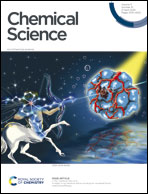Radical α-addition involved electrooxidative [3 + 2] annulation of phenols and electron-deficient alkenes†
Abstract
An electrooxidative [3 + 2] annulation of phenols and electron-deficient alkenes for the synthesis of C3-functionalized 2-aryl-2,3-dihydrobenzofuran derivatives was achieved. The ring construction starts by a unique α-addition of carbon radicals derived from anodic oxidation of phenols to electron-deficient alkenes. The subsequent anodic oxidation of the resulting alkyl radical intermediates followed by trapping with the phenolic hydroxy group assembles the 2,3-dihydrobenzofuran core. Such a pathway enables the installation of various electrophilic functionalities including alkoxycarbonyl, alkylaminocarbonyl, trifluoromethyl, and cyano groups at the C-3 of the 2,3-dihydrobenzofuran framework, which is unattainable by other intermolecular reactions. The application of this method for a rapid synthesis of a bioactive natural product is demonstrated.
![Graphical abstract: Radical α-addition involved electrooxidative [3 + 2] annulation of phenols and electron-deficient alkenes](/en/Image/Get?imageInfo.ImageType=GA&imageInfo.ImageIdentifier.ManuscriptID=D0SC01078B&imageInfo.ImageIdentifier.Year=2020)


 Please wait while we load your content...
Please wait while we load your content...